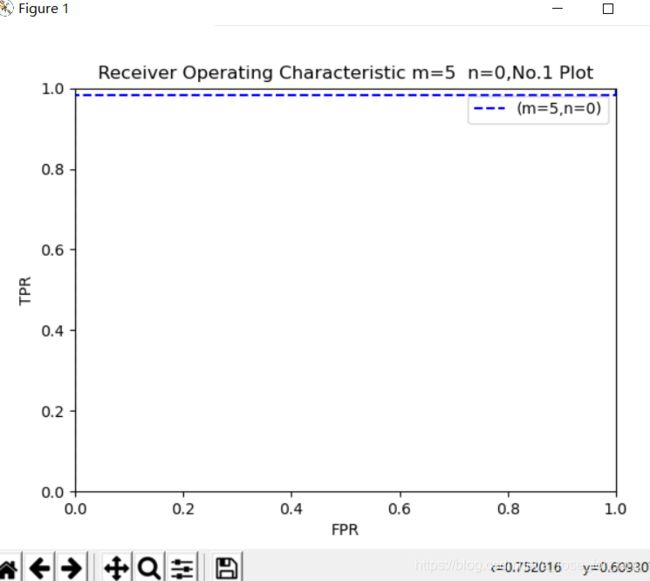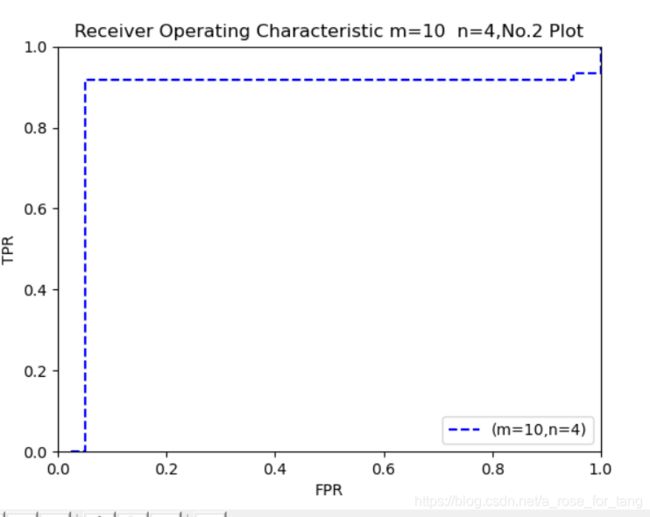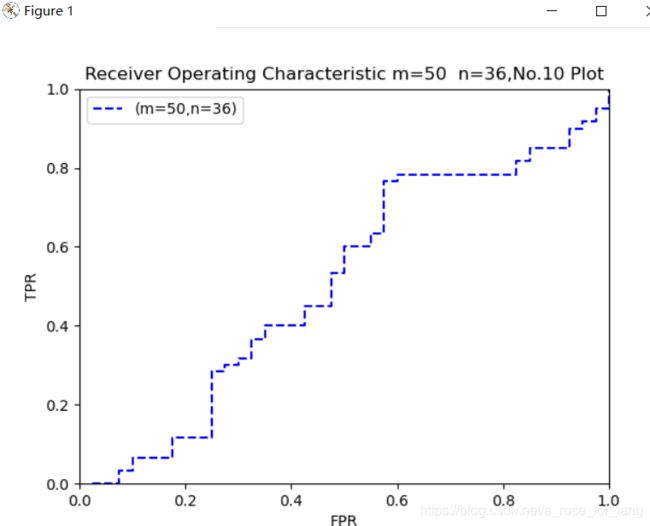ROC曲线Receiver Operating Characteristic的简单python实现
ROC曲线:x轴FPR,y轴TPR
1.背景:是机器学习的课堂作业
2.思路参考地址
参考地址:参考地址
3.实现
3.1生成100个label
首先import
import numpy as np
import matplotlib.pyplot as plt
def create_data(length):
length=int(length)
data = np.ones(length)
#plus int ,cause may make float number
data_60 = data[0:int(length*.6)]
data_40 = data[int(length*.6):] * -1
label= np.copy(np.append(data_60, data_40))
return label
3.2 生成100个score
def create_score(label,length):
score=np.copy(label)
score[0:int((length) *.6)] =score[0:int((length) *.6)] *0.7
score[int((length) *.6):] = score[int((length) *.6):] * (-.3)
return score
3.3 随机数挑选
def select_mn(length,m,n):
#https://www.e-learn.cn/topic/3362768随机数挑选
# 索引范围为[0, n),随机选x个不重复,注意replace=False才是不重复,replace=True则有可能重复
index1 =np.random.choice(np.arange(int(length*.6)),size=m,replace=False)
index2 = np.random.choice((np.arange(int(length)))[int(length*.6):], size=n, replace=False)
return index1,index2
3.4 改变 +画图函数
def plot_roc(m,n,length):
time=int(m/5)
# 定义100个数
length = length
# 在前60个数里面挑选m个数改变,后四十个数里面挑选n个数进行改变
m = m
n = n
# 创建label数组
label = create_data(length)
print('label:', (label))
# 创建score数组
score = create_score(label, length)
print('score:', score)
# 随机在里面挑选m ,n个数
index1, index2 = select_mn(length, m, n)
# print(index1,index2)
new_score = np.copy(score)
# 开始改变score的数字
for element in index1:
new_score[element] = np.random.rand()
for element in index2:
new_score[element] = np.random.rand()
print('new_score after add m and n in score : ', new_score)
# 对该数组进行从大到小的排序,以方便进行统计
new_score_copy = np.copy(np.sort(new_score, kind='quicksort'))
new_score_copy = new_score_copy[::-1]
print('new_score after sort : ', new_score_copy)
'''print('new_score:',new_score)
#从小到大排序
new_score_sort =np.sort(new_score)
#反转 a = a[::-1]从大到小
new_score_sort=new_score_sort[::-1]
print(new_score_sort)'''
x = []
y = []
# 开始统计fpr ,tpr
for threshold in new_score_copy[:]:
tpr = 0
fpr = 0
for element in new_score[:int(length * .6)]:
if element >= threshold:
tpr = tpr + 1
for element in new_score[int(length * .6):]:
if element >= threshold:
fpr = fpr + 1
x.append(float(fpr / 40))
y.append(float(tpr / 60))
print('x : is ', x)
print('y : is ', y)
label = '(m=' + str(m) + ',n=' + str(n) + ')'
plt.plot(x, y, 'b--', label=label)
title = "Receiver Operating Characteristic " + 'm=' + str(m) + ' ' + 'n=' + str(n) +",No."+str(time)+' Plot'
plt.title(title)
plt.xlim((0, 1))
plt.ylim((0, 1))
plt.xlabel("FPR")
plt.ylabel("TPR")
plt.legend()
plt.show()
return x,y
3.5 画10个图
if __name__ == '__main__':
for i in range(10):
i1=(i+1)*5
i2=(i)*4
x, y = plot_roc(m=i1, n=i2, length=100)
#x, y = plot_roc(m=45, n=23, length=100)
4.结论
当m与n 变大的时候
使得分类器变得不准了
曲线下面的面积将会变小。
就酱紫。。



